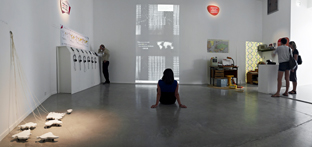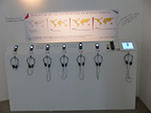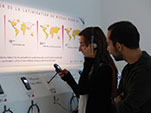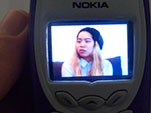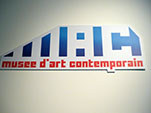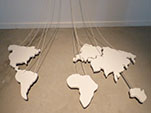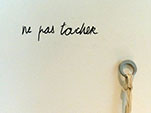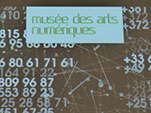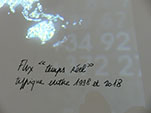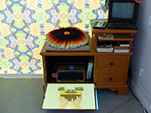Retro-Museum in 2041
performance–installation, dimensions approximately 9m x 4m, 2013
Artistic design and performance: Magali Desbazeille
Dramaturgy: Julie Valero
Graphic design: Misha Margolis
Electronic R&D: Fabrice Blaise and Baptiste Châtel
IT R&D: Jérôme Tuncer
Executive production: Cie ASAP
Producer: La Panacée, Center for Contemporary Art & Culture, City of Montpellier, Galerie des Franciscains, City of Saint Nazaire.
About the socioeconomic context of cultural and technological practices and representations in the Latin era: the telephone in 20th century museums…
Description
June 2041: The Montpellier Retro-Museum gives a typological reconstruction of four museums at the turn-of-the-century: a museum of folk traditions and art, an arts and crafts museum, a contemporary art museum and a museum of digital art. The performance-installation examines the way that we look at each of these places designed for the conservation and presentation of works, and how they trigger or direct artistic creation and the way in which we view it… The object examined, the telephone, is a cultural and artistic object, the weapon of the 20th century that enabled the worldwide dissemination of the Latin alphabet and its exclusive rein.
The True Museum of Arts and Crafts presents the testimonies of six cell phone users (Russian, Greek, Iranian, Algerian, Chinese, Korean), and two interviews with researchers. In these videos, shown on small phones, the cell phone users explain the massive Latinization that has been caused by the use of touch telephones since the beginning of the century. Languages that are written with the Cyrillic or Greek alphabet are transcribed in Latin; languages that are written with ideograms are typed out in Latin and transcribed digitally into ideograms; certain languages, like dialectal Arabic or Berber in the Maghreb, languages that had never been written before, are now written with the Latin alphabet. This impressive anthropological evolution will change, now, with the “handwrite” system…
